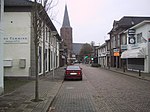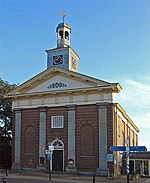The Battle of Zutphen was fought on 22 September 1586, near the village of Warnsveld and the town of Zutphen, the Netherlands, during the Eighty Years' War. It was fought between the forces of the United Provinces of the Netherlands, aided by the English, against the Spanish. In 1585, England signed the Treaty of Nonsuch with the States-General of the Netherlands and formally entered the war against Spain. Robert Dudley, Earl of Leicester, was appointed as the Governor-General of the Netherlands and sent there in command of an English army to support the Dutch rebels. When Alessandro Farnese, Duke of Parma and commander of the Spanish Army of Flanders, besieged the town of Rheinberg during the Cologne War, Leicester, in turn, besieged the town of Zutphen, in the province of Gelderland and on the eastern bank of the river IJssel.
Zutphen was strategically important to Farnese, as it allowed his troops to levy war contributions in the rich Veluwe region. Therefore, he left some troops blockading Rheinberg and marched to relieve the town. He personally supplied Zutphen at first, but as the Anglo-Dutch siege continued, he assembled a large convoy whose delivery to the town he entrusted to Alfonso Félix de Ávalos Aquino y Gonzaga, Marquis del Vasto/Guasto. Leicester learned of this when a courier dispatched by Farnese to Francisco Verdugo, the man in charge of Zutphen, was intercepted. The English and Dutch prepared an ambush, in which many English knights and noblemen were involved. In the end, the Spanish succeeded in delivering the convoy safely to Zutphen after a hard-fought battle. The Spanish cavalry, composed mainly of Italians and Albanians, was defeated by the English cavalry under the Earl of Essex. The Spanish infantry, however, held its ground and delivered the convoy to Zutphen. From there, reinforced by Verdugo, the Spanish troops forced the English to retreat.
Zutphen was secured for the Spanish, though in the following weeks the English managed to capture a major Spanish fort, Zutphen's sconce, on the bank of the IJssel river opposite the town. Most of the English gains were negated when, months later, the English governors of Deventer and Zutphen's sconce defected to the Spanish ranks and handed over their places to Farnese.












